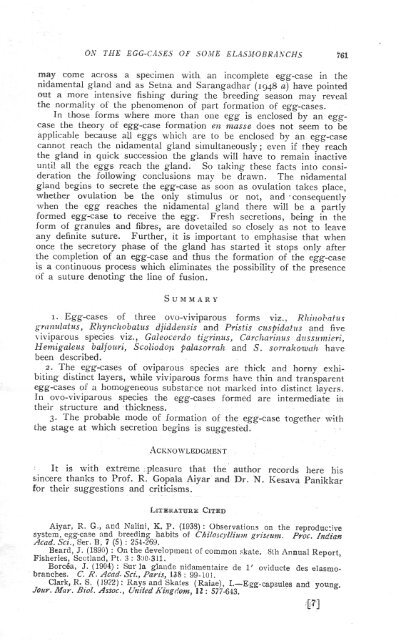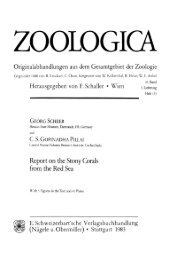observations on the egg-cases of some ovo ... - Eprints@CMFRI
observations on the egg-cases of some ovo ... - Eprints@CMFRI
observations on the egg-cases of some ovo ... - Eprints@CMFRI
You also want an ePaper? Increase the reach of your titles
YUMPU automatically turns print PDFs into web optimized ePapers that Google loves.
ON THE EGG-CASES OF SOME EL.4SMOBRANCHS '761<br />
may come across a specimen with an incomplete <strong>egg</strong>-case in <strong>the</strong><br />
nidamental gland and as Setna and Sarangadhar (1948 a) have pointed<br />
out a more intensive fishing during <strong>the</strong> breeding seas<strong>on</strong> may reveal<br />
<strong>the</strong> normality <strong>of</strong> <strong>the</strong> phenomen<strong>on</strong> <strong>of</strong> part formati<strong>on</strong> <strong>of</strong> <strong>egg</strong>-<strong>cases</strong>.<br />
In those forms where more than <strong>on</strong>e <strong>egg</strong> is enclosed by an <strong>egg</strong>case<br />
<strong>the</strong> <strong>the</strong>ory <strong>of</strong> <strong>egg</strong>-case formati<strong>on</strong> en masse does not seem to be<br />
applicable because all <strong>egg</strong>s which are to be enclosed by an <strong>egg</strong>-case<br />
cannot reach <strong>the</strong> nidamental gland simultaneously ; even if <strong>the</strong>y reach<br />
<strong>the</strong> gland in quick successi<strong>on</strong> <strong>the</strong> glands will have to remain inactive<br />
until all <strong>the</strong> <strong>egg</strong>s reach <strong>the</strong> gland. So taking <strong>the</strong>se facts into c<strong>on</strong>siderati<strong>on</strong><br />
<strong>the</strong> following c<strong>on</strong>clusi<strong>on</strong>s may be drawn. The nidamental<br />
gland begins to secrete <strong>the</strong> <strong>egg</strong>-case as so<strong>on</strong> as ovulati<strong>on</strong> takes place,<br />
whe<strong>the</strong>r ovulati<strong>on</strong> be <strong>the</strong> <strong>on</strong>ly stimulus or not, and - c<strong>on</strong>sequently<br />
when <strong>the</strong> <strong>egg</strong> reaches <strong>the</strong> nidamental gland <strong>the</strong>re will be a partly<br />
formed <strong>egg</strong>-case to receive <strong>the</strong> <strong>egg</strong>. Fresh secreti<strong>on</strong>s, being in <strong>the</strong><br />
form <strong>of</strong> granules and fibres, are dovetailed so closely as not to leave<br />
any definite suture. Fur<strong>the</strong>r, it is important to emphasise that when<br />
<strong>on</strong>ce <strong>the</strong> secretory phase <strong>of</strong> <strong>the</strong> gland has started it stops <strong>on</strong>ly after<br />
<strong>the</strong> completi<strong>on</strong> <strong>of</strong> an <strong>egg</strong>-case and thus <strong>the</strong> formati<strong>on</strong> <strong>of</strong> <strong>the</strong> <strong>egg</strong>-case<br />
is a c<strong>on</strong>tinuous process which eliminates <strong>the</strong> possibility <strong>of</strong> <strong>the</strong> presence<br />
<strong>of</strong> a suture denoting <strong>the</strong> line <strong>of</strong> fusi<strong>on</strong>.<br />
SUMMARY<br />
1. Egg-<strong>cases</strong> <strong>of</strong> three <strong>ovo</strong>-viviparous forms viz., Rhinobatus<br />
granulatus, Rhynchobatus djiddensis and Pristis cuspidatus and five<br />
v iviparous species viz., Galeocerdo tigrinus, Carcharinus dussunzieri,<br />
Hemigaleus balfouri, Scoliod<strong>on</strong> palasorrah and S. sorrakowah, have<br />
been described.<br />
2. The <strong>egg</strong>-<strong>cases</strong> <strong>of</strong> oviparous species are thick and horny exhibiting<br />
distinct layers, while viviparous forms have thin and transparent<br />
<strong>egg</strong>-<strong>cases</strong> <strong>of</strong> a homogeneous substance not marked into distinct layers.<br />
In <strong>ovo</strong>-viviparous species <strong>the</strong> <strong>egg</strong>-<strong>cases</strong> formed are intermediate in<br />
<strong>the</strong>ir structure and thickness.<br />
3. The probable mode <strong>of</strong> formati<strong>on</strong> <strong>of</strong> <strong>the</strong> <strong>egg</strong>-case toge<strong>the</strong>r with<br />
<strong>the</strong> stage at which secreti<strong>on</strong> begins is suggested.<br />
ACKNOWLEDGMENT<br />
It is with extreme :pleasure that <strong>the</strong> author records here his<br />
sincere thanks to Pr<strong>of</strong>. R. Gopala Aiyar and Dr. N. Kesava Panikkar<br />
for <strong>the</strong>ir suggesti<strong>on</strong>s and criticisms.<br />
LITERATURE CITRD<br />
Aiyar, R. G., and Nalini, K. P. (1938) : Observati<strong>on</strong>s <strong>on</strong> <strong>the</strong> reproductive<br />
system, <strong>egg</strong>-case and breeding habits <strong>of</strong> Chiloscyllium griseum. Proc. Indian<br />
Aced. Sci., Ser. B, 7 (5) : 254 -269.<br />
Beard, J. (1890) : On <strong>the</strong> development <strong>of</strong> comm<strong>on</strong> skate. Sib Annual Report,<br />
Fisheries, Scotland, Pt. 3 : 300-311,<br />
I3orcea, J. (1904) : Sur Ia glande nidamentaire de I' oviducte des elasmobranches.<br />
C. R. Acad. Sci., Paris, 138: 99-101.<br />
Clark, R. S. (1922): Rays and Skates (Raiae), I.—Egg-capsules and young.<br />
Jour. Mar. Biol. Assoc., United Kingdom, 12 : 577 -643,<br />
17]
















